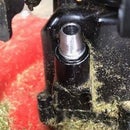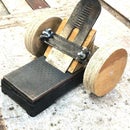Introduction: A Miter Box for a Circular Saw
I need to replace some baseboard trim in my son's house a day's drive from my workshop. I do not have a miter box, but I do have a pretty good circular saw.
The photo shows the miter box I made for my circular saw. In the photo I am testing it with some 1 x 2 furring strip. In use the saw slides across a table with the saw shoe against a fence. See the next step for a Google Sketch-Up view of the miter box.
Step 1: An Overview Image
Materials
- 1/2 inch plywood
- Finish nails
- Glue
- Screws
- Table saw
- Rule
- Square
- Hammer
- "C" clamps
- Hole saw
Step 2: First Steps
I made two pieces of plywood cut to 5 x 24 inches. In the photo a third piece of plywood 5 x 12 inches is being glued to one of the pieces 5 x 24 inches. The finish nails hold the pieces in place until the glue can dry. The other piece 5 x 24 will be glued and nailed in place to form the "U" box.
Step 3: Add the Table
Cut and glue a piece of plywood 12 x 12 inches over the open portion of the "U" box. This will be the table on which the saw moves.
Step 4: Add the Fence
I used a square with longer legs to make a reference line on the table portion. Then I used a rule to measure so I could position the fence where the edge of the saw's base plate or shoe will be. After attaching the fence with "C" clamps, I used two screws to fasten the fence to the table portion.
Step 5: Establish the Cut Line
As soon as the miter box was ready I set the saw to 45 degrees and made a cut across the table. This will aid in positioning pieces of molding for cutting. (I had not yet cut a hole with the hole saw.)
Step 6: Test
I am using two pieces of furring strip lumber. It is relatively straight. The "X" mark on each represents the top of a piece of molding for cuts that need to be a mirror opposite of each other, and not the same cut made twice, then flipped over. The pencil lines indicate roughly where the cuts will be to make a mitered corner.
Step 7: Making the Cuts
The photo shows one of the furring strips clamped in place for cutting. The end has been pulled into the miter box far enough that the saw will cut through it without removing too much and without failing to cut enough. The "C" clamp is enough to hold the furring strip snugly enough. I paid attention to the pencil marks from the previous step so the saw cut follows them and I do not make a cut the opposite of what I intended. When the first piece was cut, I inserted and clamped the second piece for its cut.
If need be, I could insert a piece of molding from the opposite end of the miter box, although I do not yet have a clamping system worked out for that arrangement. As it is, the finished side of the molding will be facing downward. That means the cut will be cleaner because the teeth of the saw blade will cut the finished surface of the molding as the teeth enter the molding, not as they exit it.
Step 8: The Result
It is a little difficult to hold two pieces inside a square and take a photo, but you can see the miter cuts make a tight corner.
I did discover the click stop on my saw's tilt setting is not quite as accurate as I would like. When I travel to my son's house to replace the two pieces of molding damaged by a young dog chewing on them, I will take these furring strips along to make some test cuts before cutting the actual molding.













